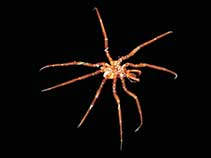Nymphon australe Hodgson, 1902
| Native range | All suitable habitat | Point map | Year 2050 |

|
| This map was computer-generated and has not yet been reviewed. |
| Nymphon australe AquaMaps Data sources: GBIF OBIS |
Classification / Names Common names | Synonyms | CoL | ITIS | WoRMS
Pycnogonida | Pantopoda | Nymphonidae
Environment: milieu / climate zone / depth range / distribution range Ecology
Benthic; depth range 0 - 4136 m (Ref. 1680). Polar
Distribution Countries | FAO areas | Ecosystems | Occurrences | Introductions
Southeast Pacific, Western Atlantic, and Antarctic.
Length at first maturity / Size / Weight / Age
Maturity: Lm ? range ? - ? cm
Short description Morphology
Leg span: 2 - 3 cm, a tall ocular tubercle with prominent eyes, and closely crowded lateral processes which usually, along with the trunk, have long dorsal spines. Spines are also carried on the chelifore scape and in rows along the leg. It has a short neck, crowded with a bulbous oviger base on each side. The male ovigers have distally inflated fifth and sixth segments which are often collapsed. The tarsus, with strong distal spines, is usually as long as or longer than the propodus which has a short main claw and vestigial or missing auxiliary claws. A wide range of variations occur among the many specimens of this species. This is attested to by its several synonyms. This is the genotype of a group of 20 predominantly Antarctic species which belong to a discrete assemblage called the australe group (Ref. 156). It shares the diagnostic characters enumerated above with the others and forms one of the groups into which this cumbersome genus must be divided if any sense is to be made of trying to separate its multitude of species (Ref. 9).
Maximum depth from Ref. 87394. Found to have hydroid colonies grasped in its chelifores (Ref. 121217).
Life cycle and mating behavior Maturity | Reproduction | Spawning | Eggs | Fecundity | Larvae
Members of the class Pycnogonida are gonochoric and sexually dimorphic. During copulation, male usually suspends itself beneath the female. Fertilization occurs as the eggs leave the female's ovigers. Males brood the egg masses until they hatch. Life cycle: Eggs hatch into protonymphon larva then to adults.
Main reference
References | Coordinator | Collaborators
Child, C.A. 1998. (Ref. 9)
IUCN Red List Status (Ref. 130435)
CITES status (Ref. 108899)
Not Evaluated
CMS (Ref. 116361)
Not Evaluated
Threat to humans
Human uses
| FishSource |
Tools
More information
Internet sources
BHL | BOLD Systems | CISTI | DiscoverLife | FAO(Publication : search) | Fishipedia | GenBank (genome, nucleotide) | GloBI | Gomexsi | Google Books | Google Scholar | Google | PubMed | Tree of Life | Wikipedia (Go, Search) | Zoological Record
Estimates based on models
Preferred temperature
(Ref. 115969): -1.9 - 2.1, mean 0.6 (based on 1187 cells).
Price category
(Ref. 80766):
Unknown.



